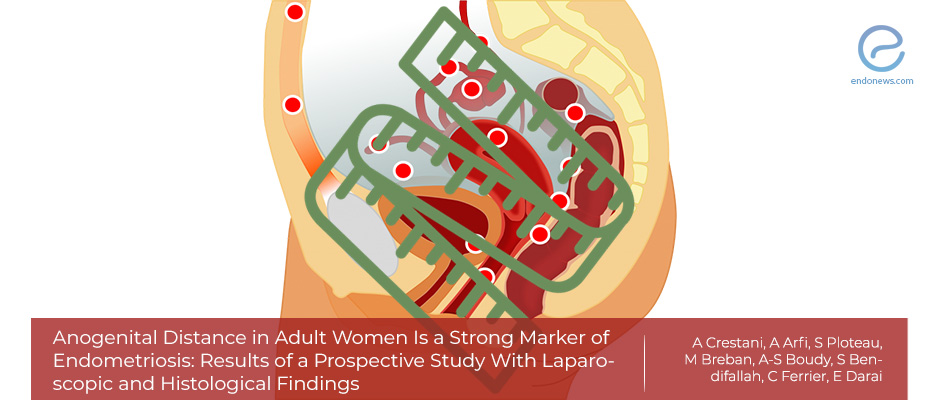Anogenital distance and endometriosis
Jul 3, 2020
A short anogenital distance is strongly associated with the presence of endometriosis.
Key Points
Highlights:
- Anogenital distance (AGD) was not found to be correlated either to the severity or to the location of the disease.
Importance:
- A short AGD can be used as a non-invasive marker of endometriosis, particularly in adolescents and virgin women to avoid diagnostic laparoscopy and empiric treatment.
What's done here:
- This prospective cohort study analyzed the link between anogenital distance and endometriosis in 168 adult women undergoing pelvic surgery.
- The measurements of the distance from the clitoral surface to the anus (AGD-AC) and from the posterior fourchette to the anus (AGD-AF) before surgery using a millimeter accuracy ruler.
- Results of 98 surgically proved and histologically confirmed endometriosis patients compared to 70 women without endometriosis.
Key results:
- Mean AGD-AF measurements were 21.5 mm and 32.3 mm, and average AGD-AC measurements were 100.9 mm and 83.8 mm in the endometriosis and non-endometriosis groups, respectively.
- For AGD-AF, an optimal cut-off of 20 mm had a specificity of 0.986 sensitivity of 0.306 with a positive predictive value of 0.969.
- For discriminating the presence of endometriosis, AGD-AF was found to have a better predictive value than AGD-AC.
- AGD-AF and AGD-AC measurements were independent of the r-ASRM stage or ENZIAN score; showing that there is no correlation between AGD and the severity or location of the disease.
- The diagnosis of endometriosis was found to be the only variable independently associated with the AGD-AF.
Limitations:
- The sample size was relatively small
- The proportion of patients with colorectal endometriosis is high
- Adolescent endometriosis patients were not included in the study.
Lay Summary
Endometriosis may be associated with exposure of the embryo to chemicals called ‘endocrine disruptors’. Exposure to endocrine disruptors can be estimated by measuring the anogenital distance (i.e. the distance between the clitoris and the anus), using a centimeter ruler with millimeter accuracy.
This information is according to a research article published in the journal "Human Reproduction Open", a team led by Dr. Crestani.
The team compared the anogenital distance in 168 patients with and without endometriosis in their prospective cohort study from January 2018 to June 2019 in the tertiary-care Tenon University Hospital in Paris, France.
Before surgery, the distance from the clitoral surface to the anus (AGD-AC) and from the posterior fourchette to the anus (AGD-AF) was measured by an operator using a millimeter accuracy ruler. The abdominopelvic cavity was explored to assess the diagnosis of endometriosis and to calculate the relation with r-ASRM and ENZIAN scores. The Enzian score distributes the lesions into one of three compartments and severity grades. All tissues removed during the surgery underwent pathological examination. Of 168 participants, 98 had endometriosis (endometriosis group) and 70 did not (non- endometriosis group).
The authors showed that the AGD measurement may constitute a non-invasive diagnostic alternative for endometriosis. They also detected that AGD-AF is a better marker than AGD-AC. Their findings demonstrated a cut-off of 20 mm for AGD-AF had a specificity of 0.98 and a positive predictive value of 0.969 for AGD-AF which supports its use as a physical marker of endometriosis.
Importantly, a short AGD-AF was found to be independent of r-ASRM and Enzian classification. AGD-AF measurements were independent of the presence of endometrioma and the extent of deep infiltrating endometriosis even in patients with colorectal infiltration.
According to the authors, this is the first study to show the association of surgically and histologically proven endometriosis with a short AGD, and especially AGD-AF, in women of reproductive age. The diagnosis of endometriosis proved surgically and confirmed by histopathology is the strength of this study. The authors recommend an evaluation of the potential psychological effect and patient acceptance of performing this measurement during routine gynecologic visits.
Research Source: https://pubmed.ncbi.nlm.nih.gov/32529050/
endometriosis environmental effects in utero exposure surgery anogenital distance endometrioma endometriosis stages abdominopelvic cavity

